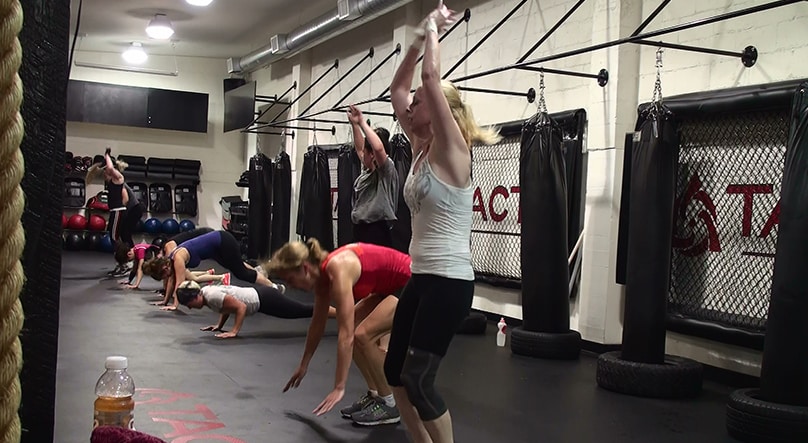The social aspect of a CrossFit class is one of the most appealing things about the fitness program. You can come in, socialize, motivate and get motivated and push yourself to a place you never thought you could go. Surrounding yourself with people who are suffering through the same ordeal as you has a funny way of making you work that much harder—I’m not exactly sure why that’s the case, but it’s true. But what happens when you’re working out and you’re literally surrounded by people? All of sudden, your experience of CrossFit changes dramatically.
Now, some of you may have a personal preference in regards to class sizes. Some may enjoy the more intimate feel of a 5-person class while others are drawn to the noise and vibes of larger group settings. In some instances you may not have a choice of what class time you attend (due to work or other commitments), which often means that you are forced into the most popular class of the day. Depending on what box you go to, this might mean that you are working out in a class size that is simply too big. Here’s how you know that that’s the case.
Jump to:
The coach to athlete ratio is ineffective
With regards to athletes vs. coach class sizes, the general consensus among the majority of box-goers is that anything above a 15 to 1 ratio is pushing the limit. Simply put, if the coach(es) can’t effectively keep an eye on all their athletes to ensure they are performing movements safely and effectively then the class is either too big or it needs more coaches.
You don’t feel like you are receiving the personal attention you require
Even the most seasoned CrossFitter needs help sometimes, and every athlete wants to know what to do to become more proficient at X Y and Z. Naturally, the first step is to ask your coach to critique your lifts and give you pointers. This doesn’t mean your coach has to act like a personal trainer and follow you around for the entire duration of the class, but a quick check-in here and there alongside some helpful instruction can make all the difference in the world. If the class is of a suitable size a coach should be able to check on each one of his or her athletes individually. If, on the other hand, you spend the entire class trying to figure out the finer points of the snatch on your own, then there’s a problem. Either your coach is incredibly lazy, or the class is so large that he or she isn’t able to adequately check on each athlete. Not only is this a sign that you’re not getting good value for your money, but an athlete can unknowingly be developing bad habits that may lead to injury.
You don’t have personal space
Speaking of safety, a typical CrossFit WOD involves flailing limbs and falling weights, so it is absolutely imperative that an athlete has adequate room to maneuver, execute a full range of motion (such as a kettlebell swing requires) and drop a barbell if necessary. If you and your fellow CrossFitter’s are packed in to the box like sardines, I doubt you’ll feel all that comfortable performing burpees or any OLY lift for fear of landing on or striking someone else. That can really ruin your CrossFit buzz when you should be focusing on performing the task(s) at hand.
There isn’t enough equipment available
Ok, so the WOD calls for a kettlebell, a box and a jump rope. Annnnnnd only one of those items is available. Your coach may be able to stagger the class so athletes start on different stations, but if this is not an option (people are cycling too quickly, etc.) you’ll either find yourself standing around waiting to use the equipment or you’ll have to perform variations of each movement that change the WOD completely! There aren’t too many things that can infuriate a CrossFitter more than getting excited for a certain workout only to find that they’re doing something completely different (and worse) instead.
What can you do?
So, what options do you have if you find that the class you work out in is getting more and more crowded? One would hope that the affiliate and coaches have noticed that certain classes are more popular than others and they already have a cap system in place that prevents athletes from registering to work out if the limit is reached. If for some reason this doesn’t apply to your affiliate, the best thing you can do is speak to your coach privately and make them aware of your concerns. Suggest to the other athletes with the same worries that they do the same, and hopefully your coach will get the picture. Your workouts, your coaches’ jobs and your affiliate’s reputation will be that much better for it.
Photo courtesy of Kepler Fontenele/CC BY-NC-SA 2.0
















I just read u r article on class size and from experience I left a box because of the size of the classes. Now from the stand point of being a paid firefighter the span of control for one person is recommended at 3 to 5 people and max at 7 I personally feel that this needs to be applied to crossfit because of the movements that are required in some cases and can control the environment and reduce injuries and give more encouragement to the athletes